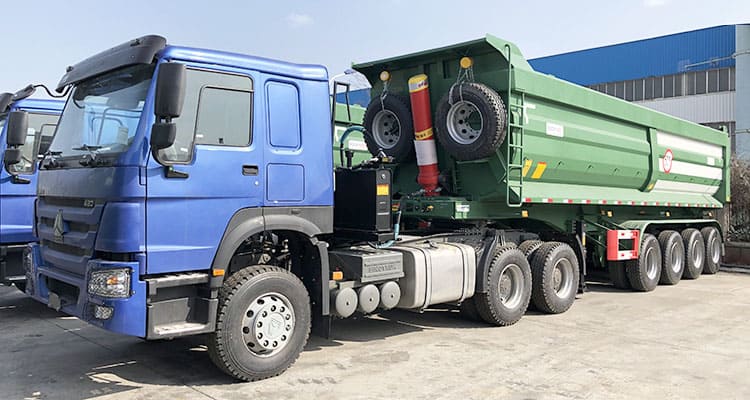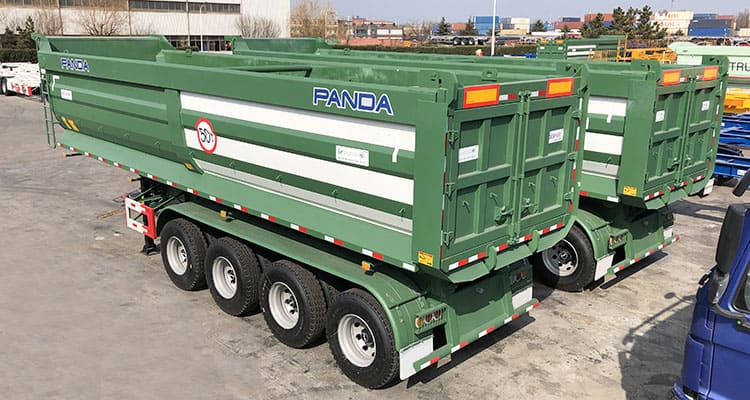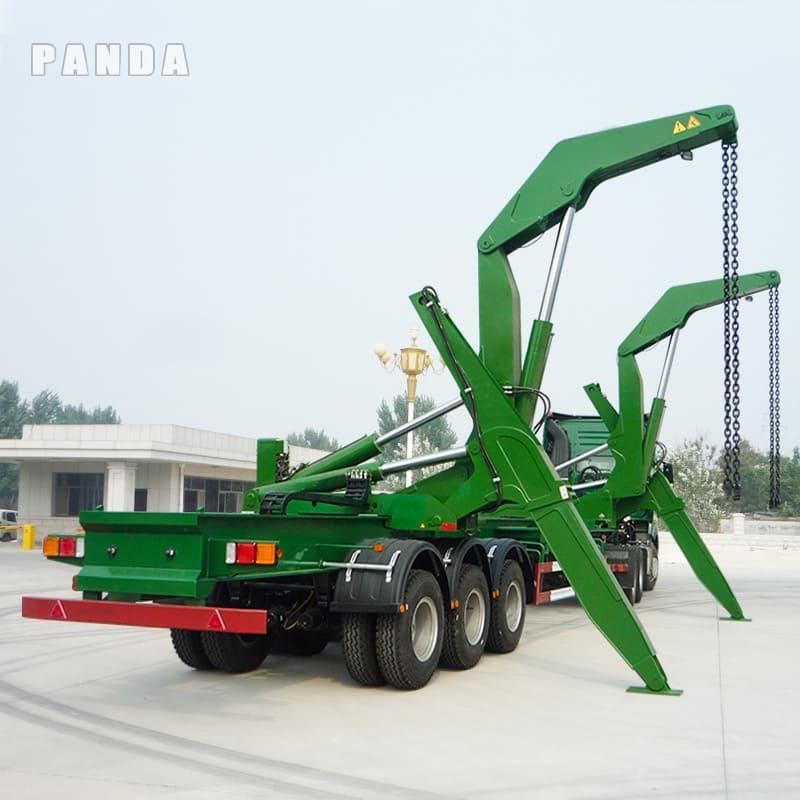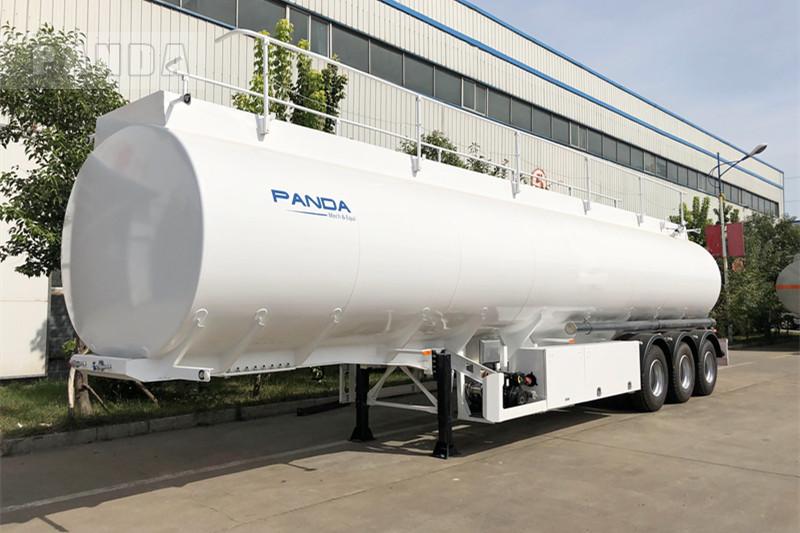How Much Does Tipper Trailer Cost in 2025? Prices range from $15,000 to over $40,000, depending on the type, size, and features. A basic dump semi trailer typically costs less than a side tipper trailer equipped with advanced technology. The setup plays a crucial role! Factors like materials, size, and additional features such as hydraulic systems significantly impact the price.

If you’re considering purchasing a tipper trailer, understanding these details can help you make an informed decision. The best tipper trailer isn’t solely about the cost—it’s about how effectively it meets your business’s needs.
How Much Does Tipper Trailer Cost in 2025?
Average Price Range for Tipper Trailers
Tipper trailers in 2025 usually cost $10,000 to $40,000. The price depends on the type, features, and quality. Basic models are cheaper, closer to $10,000. Premium trailers with advanced hydraulics or special designs can cost $40,000 or more.
Here’s a simple breakdown:
- Basic models: $15,000-$25,000. Good for small jobs.
- Mid-range options: $20,000-$40,000. Better materials and bigger sizes.
If you’re asking, “How much does tipper trailer cost for me?” start by setting your budget. Focus on the features you really need. This helps avoid spending extra on things you don’t use.
Cost Variations by Size and Capacity
The size and capacity of a tipper trailer affect its price. Bigger trailers with higher loads cost more. For example, a trailer for 20 tons costs more than one for 10 tons. Pick a trailer that matches your work needs.
Here’s how size and capacity change prices:
| Capacity | Estimated Cost | Best For |
|---|---|---|
| 25-40 tons | $15,000-$25,000 | Small jobs or light tasks |
| 30-70 tons | $20,000-$40,000 | Medium-sized work |
Not sure what size to pick? Think about your usual load. Overloading a small trailer can cause damage. A big trailer not fully used wastes money.

Regional Pricing Differences
Tipper trailer prices change based on where you buy them. In 2025, areas with more factories or lower shipping costs have better deals. For example, trailers are cheaper near local manufacturers than in places relying on imports.
Here’s what I’ve noticed:
- North America: Higher prices due to advanced tech and strict rules.
- Asia: Cheaper, especially in places like China and India.
- Europe: Mid-range prices, focusing on quality and eco-friendliness.
- Africa and South America: Prices vary due to import taxes and demand.
If buying internationally, add shipping and customs fees to your budget. Sometimes, buying locally saves money over time.
Cost Trends and Predictions for 2025
What’s happening with tipper trailer prices in 2025? Let me explain simply. Prices are changing because of important market trends. Here’s what’s going on:
- Rising Material Costs 🏗️
Steel and aluminum prices are increasing. These materials make trailers strong. As costs go up, buyers pay more. Trailers with better materials will cost extra. - Technology Integration 🤖
Features like GPS, smart hydraulics, and sensors are common now. These tools make trailers work better but raise prices. High-tech trailers cost more but save money later. - Environmental Regulations 🌍
Governments want eco-friendly trailers. Companies use lighter materials and fuel-saving systems to follow rules. These changes make production expensive, raising trailer prices. - Global Supply Chain Challenges 🚢
Shipping problems are still happening in 2025. Delays and higher transport costs increase prices, especially for imports. Buying from local makers might be cheaper. - Market Demand 📈
Construction and mining are growing fast. More people need tipper trailers, so prices are rising. If demand is high where you live, expect higher costs.
What’s my prediction? Prices will keep going up, especially for eco-friendly and smart models. Don’t worry! You can still save money. Buy from local makers, compare choices, and think about long-term value instead of just upfront costs.
Factors That Affect Tipper Trailer Prices

Material and Build Quality
The materials used in a tipper trailer affect its price. Strong materials like steel or aluminum last longer but cost more. Cheaper materials save money at first but may need repairs later.
For instance, aluminum trailers are light and don’t rust. They’re great for long-term use. Steel trailers are heavier and better for tough jobs. If you carry light loads, aluminum is a good choice. For construction or mining, steel works best.
Brand and Manufacturer Reputation
The brand you pick can change the trailer’s price. Famous brands charge more because they’re trusted for quality. But smaller brands can also be worth checking out.
Here’s what I’ve learned about big brands:
- Pros: They offer good warranties, support, and resale value.
- Cons: You might pay extra just for the name.
Smaller brands often have lower prices to attract buyers. Still, you should research them. Read reviews, ask others, and check safety standards.
Features and Technology
Modern features can raise the price of a tipper trailer. Tools like GPS, hydraulic lifts, and sensors make work easier but cost more.
Here are some features to think about:
- Hydraulic Systems: These help unload faster. Advanced ones cost more but save time.
- GPS and Tracking: These show where your trailer is and how it’s working. They’re useful for managing fleets.
- Eco-Friendly Designs: Light materials and fuel-saving systems are popular. They cost more now but save money later.
Note: Only pay for features you’ll use. Fancy tools are nice but not worth it if you don’t need them.
Market Demand and Supply Chain Impact
Market demand and supply chain problems affect tipper trailer prices. When more people want trailers or supplies are delayed, costs rise. Let me explain:
1. 📈 More Demand for Tipper Trailers
In 2025, industries like farming, mining, and building are growing fast. These industries need trailers to carry heavy loads easily. As more companies buy trailers, prices go up. It’s simple—more demand means higher prices.
2. 🚢 Supply Chain Problems
Supply chain issues are still a problem in 2025. Delays, material shortages, and fuel costs make trailers more expensive. For example:
- Steel and Aluminum Shortages: These materials are key for trailers. When they’re scarce, prices increase.
- Shipping Costs: Importing trailers or parts adds extra fees.
Tip: To save money, buy from local makers. They avoid high shipping and customs costs.
3. 🌍 Demand Differences by Region
Demand isn’t the same everywhere. In fast-growing places like Asia and Africa, trailer prices are rising. In slower-growing areas, prices stay steady.

Maintenance and Warranty Costs
Maintenance and warranty costs matter when buying a tipper trailer. These costs add up, so plan ahead. Here’s what to know:
1. 🛠️ Regular Maintenance
Trailers need care to work well. This includes:
- Hydraulic System Checks: Fixing hydraulic systems is costly if ignored.
- Tire Replacements: Heavy loads wear out tires fast. Replacing them costs a lot.
- Rust Prevention: Steel trailers need rust-proofing, especially in wet areas.
Pro Tip: Do regular maintenance to avoid big repair bills. A cared-for trailer lasts longer.
2. 📜 Warranty Coverage
Most trailers come with warranties, but coverage varies. Some cover small fixes, others include major parts like hydraulics.
- Short Warranties (1-2 years): Common for cheaper trailers. They cover small issues but not big repairs.
- Extended Warranties (3-5 years): Cost more upfront but save money on big repairs later.
| Warranty Type | What It Covers | Cost Impact |
|---|---|---|
| Basic Warranty | Small fixes (1-2 years) | Cheaper upfront |
| Extended Warranty | Big parts (3-5 years) | Costs more, saves later |
Note: Read warranty details before buying. Some don’t cover tires or brakes.
3. 🔧 Spare Parts Costs
Spare parts can be expensive, especially for high-tech trailers. For example, replacing a hydraulic pump or GPS system costs a lot. Picking a trailer with easy-to-find parts saves money.
Final Thought: Maintenance and warranty costs may seem small now, but they add up. Plan for these costs to avoid surprises later.
Types of Tipper Trailers and Their Cost Per Ton

Semi Tipper Trailers
Standard tipper trailers are the most common type you’ll find. They’re designed for general use, like hauling sand, gravel, or construction debris. These trailers have a simple design with a rear hydraulic system that tilts the bed for unloading. If you’re looking for something versatile, this is a great option.
The cost per ton for standard tipper trailers is usually lower compared to other types. Why? Their design is straightforward, and they don’t have extra features that drive up the price. For example, a semi tipper trailer might cost around $15,000 to $40,000. Pretty reasonable, right?
Tip: If you’re on a budget, start with a standard tipper trailer. It’s reliable and gets the job done without breaking the bank.

Side Tipper Trailers
Side tipper trailers are perfect for tight spaces. Instead of tipping backward, they unload to the side. This makes them ideal for jobs where space is limited, like mining sites or narrow roads. They’re also great for carrying materials that need to be spread out evenly, like soil or grain.
The cost per ton for side tipper trailers is slightly higher. Why? Their design is more complex, and they often use advanced hydraulic systems. For a side tipper trailer, you might pay between $25,000 and $40,000.
Note: Side tippers are a smart choice if you need flexibility. They save time and effort in tricky unloading situations.
Tips for Cost-Effective Tipper Trailer Purchases
Comparing Prices Across Vendors
Looking at different sellers helps you save money. Always check prices from several vendors before buying. Sellers often charge different amounts for the same tipper trailer. Some may include free extras or offer discounts.
Here’s how to do it:
- List sellers: Include local shops, online stores, and manufacturers.
- Ask for prices: Get detailed quotes, including delivery or setup fees.
- Compare extras: Look at warranties, maintenance plans, and included features.
Pro Tip: Buying more than one trailer? Ask for bulk discounts. Sellers may lower the price.
Evaluating Long-Term Value Over Initial Cost
Cheapest isn’t always the smartest choice. Spending more upfront can save money later. A pricier trailer might last longer or need fewer repairs.
Here’s what to think about:
- Strong materials: Aluminum or steel trailers last longer.
- Fuel savings: Some trailers use less fuel, saving money over time.
- Easy repairs: Trailers with good warranties or common parts cost less to fix.
Note: Don’t just look at the price tag. Add up costs like fuel, repairs, and maintenance over the trailer’s life.
Considering Used or Refurbished Options
Used trailers can save you money. Many buyers find great deals on second-hand trailers. But you need to check them carefully to avoid problems.
Here’s a simple checklist:
- Check for damage: Look for rust, wear, or broken parts.
- Test hydraulics: Make sure the lifting system works well.
- Review past care: Trailers with good maintenance records are better.
- Try it out: If possible, test the trailer to see how it works.
Tip: Buy from trusted sellers. They often offer warranties or return options for peace of mind.
Negotiating Discounts and Deals
Want to save money on your tipper trailer purchase? Negotiating is key! Many buyers don’t realize how much wiggle room there is in pricing. Let me share a few tips that have worked for me.
- Ask for Discounts 🤑
It sounds simple, but you’d be surprised how often sellers are willing to lower the price if you just ask. Whether it’s a seasonal sale or a bulk discount, there’s usually some room to negotiate. - Bundle Purchases 📦
If you’re buying more than one trailer or adding accessories, ask for a package deal. Sellers often give discounts when you buy multiple items together. - Leverage Competitor Pricing 🏷️
If you’ve found a better price elsewhere, let the seller know. They might match or even beat the competitor’s offer to win your business. - Negotiate Extras 🎁
Even if the price isn’t flexible, you can ask for extras like free delivery, extended warranties, or maintenance packages. These add-ons can save you money in the long run.
Pro Tip: Be polite but firm. Sellers are more likely to work with you if you’re respectful and clear about your budget.
Remember: Negotiation isn’t just about the price tag. It’s about getting the best overall value for your money.
Extra Costs for Tipper Trailers
Maintenance and Spare Parts Costs
Taking care of your trailer isn’t free. Regular maintenance and replacing parts can get expensive. Here’s what you should know:
Common Maintenance Tasks 🔧
- Hydraulic System Checks: Cost $200 to $500 per service.
- Tire Replacements: Tires wear out fast. Each tire costs $300 to $600.
- Rust Protection: Steel trailers need rust-proofing, costing $100 to $300 yearly.
Spare Parts Prices ⚙️
Some parts are pricier than others. Here’s a quick list:
| Part | Estimated Cost |
|---|---|
| Hydraulic Pump | $1,000 – $2,000 |
| Brake System | $300 – $600 |
| Axles and Bearings | $100 – $500 |
Note: Regular care avoids big repair bills. A well-maintained trailer lasts longer and saves money over time.
How to Choose a Tipper Trailer Manufacturer?
Picking the right tipper trailer manufacturer is very important. It helps you get good quality and value. Here’s how to decide:
1. Check Experience and Reputation 🏆
Experienced manufacturers make strong and reliable trailers. Look at reviews or ask others in your field. A popular brand often means better products and service.
Tip: Talk to people in your industry. They can tell you which brands are trustworthy.
2. Look at Materials and Build Quality 🔍
Trailers are not all made the same way. Some use strong steel or aluminum, while others use cheaper materials. Check how well the trailer is built and ask about the materials.
| Material | Strength | Best For |
|---|---|---|
| High-Grade Steel | Very strong | Heavy-duty jobs |
| Aluminum | Light, no rust | Long-term, light loads |
Note: Cheap materials may cost less now but need more repairs later.
3. Test Customer Support 🤝
Good companies help their customers. Do they offer warranties? Is it easy to contact them for help? These things are important for repairs or replacements.
Pro Tip: Pick a company with a good warranty. It shows they trust their product.
4. Compare Prices and Value 💰
Price is important, but so is what you get for it. Don’t just pick the cheapest option. See what each company includes, like free delivery or extra services.
5. Ask About Custom Features 🛠️
Every business has different needs. Some companies let you add special features, like GPS or custom hydraulics. If you need something specific, check if they can do it.
6. Think About Location 🌍
Local companies can save you money on shipping and repairs. Plus, you can visit them to see the trailers yourself.
Final Thought: Take your time to choose the right manufacturer. Focus on quality, reputation, and support. A good company will save you money and problems later.
FAQ
How long does a tipper trailer last?
A tipper trailer usually lasts 10-15 years. Taking care of it, like checking hydraulics and preventing rust, helps it last longer. Using it for tough jobs might make it wear out faster.
Can I make changes to a tipper trailer?
Yes, many manufacturers let you customize trailers. You can add things like GPS, better hydraulics, or eco-friendly features. Custom trailers cost more but work better for special needs.
Are used tipper trailers worth buying?
Used trailers can save money if checked well. Look for rust, damage, or hydraulic problems. A cared-for used trailer can work as well as a new one but costs less.
How do I pick the right trailer size?
Choose a size based on your usual load. For small jobs, a 10-15 ton trailer is fine. For bigger tasks, pick 25+ tons. Overloading can break trailers, so pick carefully.
Do tipper trailers have warranties?
Yes, most trailers come with warranties. Basic ones last 1-2 years and cover small fixes. Longer warranties (3-5 years) cover big parts like hydraulics but cost more.



